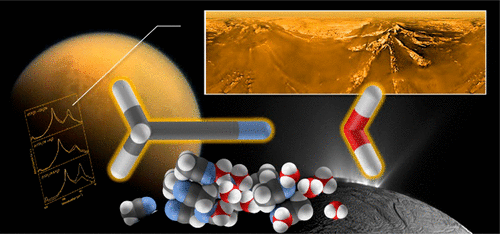当前位置:
X-MOL 学术
›
ACS Earth Space Chem.
›
论文详情
Our official English website, www.x-mol.net, welcomes your feedback! (Note: you will need to create a separate account there.)
Binary-Phase Acetonitrile and Water Aerosols: Infrared Studies and Theoretical Simulation at Titan Atmosphere Conditions
ACS Earth and Space Chemistry ( IF 3.4 ) Pub Date : 2018-07-11 00:00:00 , DOI: 10.1021/acsearthspacechem.8b00059 Rebecca Auchettl 1 , Mahmut Ruzi 1 , Dominique R. T. Appadoo 2 , Evan G. Robertson 1 , Courtney Ennis 1
ACS Earth and Space Chemistry ( IF 3.4 ) Pub Date : 2018-07-11 00:00:00 , DOI: 10.1021/acsearthspacechem.8b00059 Rebecca Auchettl 1 , Mahmut Ruzi 1 , Dominique R. T. Appadoo 2 , Evan G. Robertson 1 , Courtney Ennis 1
Affiliation

|
Acetonitrile (CH3CN) and water (H2O) ice particles were generated within a collisional cooling cell coupled to the Australian Synchrotron light source. The evolution of the aerosols was tracked by infrared spectroscopy compiled over the 4000–50 cm–1 region. Gas pressure and temperature conditions were varied to replicate the lower altitudes of the Titan atmosphere allowing for comparison to far-infrared features detected by the Cassini–Huygens spacecraft. The experimental spectra show that CH3CN and H2O particles are microheterogeneous in composition and spherical in shape. CH3CN lattice bands display temperature-dependent shifts in frequency, implying that pure β-phase is present in the mixed particles. In addition, a red shift identified for the C≡N fundamental stretching mode indicates dipole–dipole and π-electron side-directed hydrogen bond coupling between segregated CH3CN and H2O phases exclusively at the grain interface. Discrete dipole approximation theory was implemented to evaluate various cluster architectures where segregated domains of pure CH3CN and H2O ices provided the best fit to experiment; confirming the infrared findings. Otherwise, simulations of competing architectures, such as core–shell and cubic shaped particles, did not provide convincing comparison to the aerosol spectra. We conclude that the far-infrared profiles for mixed CH3CN–H2O systems do not present as likely carriers for the unassigned 220 cm–1 “haystack” feature that has been identified in Titan’s lower atmosphere.
中文翻译:

二元乙腈和水气溶胶:泰坦大气条件下的红外研究和理论模拟
乙腈(CH 3 CN)和水(H 2 O)冰粒是在与澳大利亚同步加速器光源耦合的碰撞冷却池内产生的。气溶胶的演变通过在4000–50 cm –1区域内汇编的红外光谱进行跟踪。改变气压和温度条件可以复制泰坦大气的较低高度,从而可以与卡西尼-惠更斯号航天器探测到的远红外特征进行比较。实验光谱表明,CH 3 CN和H 2 O颗粒在组成上微异质,在形状上呈球形。通道3CN晶格带显示随温度变化的频率变化,这意味着在混合颗粒中存在纯β相。此外,对于C≡N基本拉伸模式识别出的红移表明,仅在晶粒界面处,在分离的CH 3 CN和H 2 O相之间偶极子-偶极子和π电子侧向氢键耦合。实施离散偶极近似理论来评估各种簇结构,其中纯CH 3 CN和H 2的隔离域冰提供了最适合实验的条件;确认红外线的发现。否则,对竞争性体系结构(如核-壳和立方状颗粒)的仿真无法提供与气溶胶光谱的令人信服的比较。我们得出的结论是,混合的CH 3 CN–H 2 O系统的远红外轮廓未显示为尚未分配的220 cm –1 “干草堆”特征的可能载体,该特征已在土卫六的低层大气中确定。
更新日期:2018-07-11
中文翻译:

二元乙腈和水气溶胶:泰坦大气条件下的红外研究和理论模拟
乙腈(CH 3 CN)和水(H 2 O)冰粒是在与澳大利亚同步加速器光源耦合的碰撞冷却池内产生的。气溶胶的演变通过在4000–50 cm –1区域内汇编的红外光谱进行跟踪。改变气压和温度条件可以复制泰坦大气的较低高度,从而可以与卡西尼-惠更斯号航天器探测到的远红外特征进行比较。实验光谱表明,CH 3 CN和H 2 O颗粒在组成上微异质,在形状上呈球形。通道3CN晶格带显示随温度变化的频率变化,这意味着在混合颗粒中存在纯β相。此外,对于C≡N基本拉伸模式识别出的红移表明,仅在晶粒界面处,在分离的CH 3 CN和H 2 O相之间偶极子-偶极子和π电子侧向氢键耦合。实施离散偶极近似理论来评估各种簇结构,其中纯CH 3 CN和H 2的隔离域冰提供了最适合实验的条件;确认红外线的发现。否则,对竞争性体系结构(如核-壳和立方状颗粒)的仿真无法提供与气溶胶光谱的令人信服的比较。我们得出的结论是,混合的CH 3 CN–H 2 O系统的远红外轮廓未显示为尚未分配的220 cm –1 “干草堆”特征的可能载体,该特征已在土卫六的低层大气中确定。


























 京公网安备 11010802027423号
京公网安备 11010802027423号